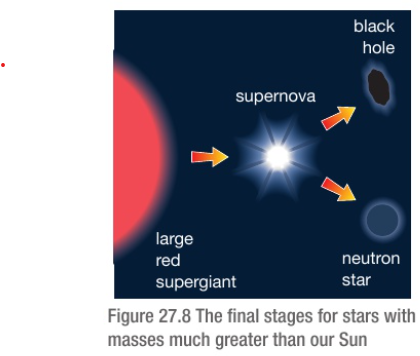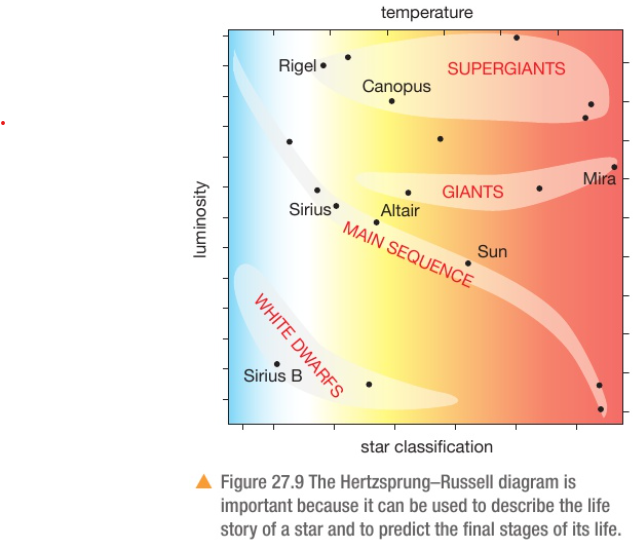Astrophysics part 2: stellar evolution
1/27
Earn XP
Description and Tags
Name | Mastery | Learn | Test | Matching | Spaced |
|---|
No study sessions yet.
28 Terms
Astrophysics 2
What kind of galaxy is our galaxy?
The Milky Way is a spiral galaxy
Stars can be classified based on their ___
Colour
What does the colour of a star tell us about it?
Their surface temperature
What colour will a very hot, medium hot and cool star look like?
A very hot star looks blue
A medium hot star like the Sun looks yellow
A cool star looks red
Why is a hot star blue?
Hotter stars emit shorter wavelength light which we see as blue and the shorter the wavelength the higher the frequency which means more energy
TRIPLE CONTENT: What does the brightness of a star depend on seen from Earth?
Distance the star is from the Earth
The luminosity of the star — how much energy is transferred from the star each second
En el revison guide pone que the size also matters (dice que generally the bigger and hotter the star, the brighter)
Therefore taking account that, what are the three ways in which astronomers decide the brightness of a star?
The apparent brightness/magnitude of a star
The absolute brightness/magnitude of a star
The luminosity of a star
What does it mean by the apparent brightness/magnitude of a star?
A measure of how bright a star appears in the night sky seen from Earth
Define the term absolute magnitude (2)
A measure of brightness
of a star at a fixed/same/set distance
A measure of how bright the stars would appear if they were all placed the same distance away from the Earth.
What advantage is there when using the method of looking at the absolute magnitude to measure the brightness of a star?
Which star is brighter? One with magnitude +5 or -5?
Scientists can make comparisons between stars.
The star with the absolute magnitude of -5 is brighter.n Very bright stars hav e a negative value for their abolute magnitudes
END OF TRIPLE: What does it mean by the luminosity of a star?
This measures how much energy in the form of light id emitted from a star’s surface every second
Evolution of a star of similar mass to the Sun
What are the stages?
Nebula
Star (main sequence)
Red giant
White dwarf
How is an initial form of a star created (nebula)?
Stars form from large clouds of dust and gas particles we call nebula and are drawn together by gravitational forces over millions of years
As particles get closer the temperature and pressure increase
Nuclear fusion reactions in the core begin bc of this
Hydrogen nuclei join together to make a larger nuclei, a helium nuclei
This releases enourmous amounts of energy in the form of heat and light
This very hot ball of gas is a very young star.
The appearance of a star changes gradually with time. These changes follow a pattern.
How does a nebula evolve into a star (main sequence)?
When a star first forms (la nebula) the fusion produces forces (al parecer se llama thermal expansion) that push the particles apart as the gas in the star expands outwards because of the high temps but the gravitational forces are always pulling the particles together.
When these opposing forces are balanced, the star is in its main stable period and is called a main sequence star.
This period can last for billions of years (this is the stage the Sun is in) and stays at a constant size and temp
The heavier the star, the (longer/shorter) its time on the main sequence
Shorter
How does a star evolve after the stage of star (main sequence)?
Eventually there are less hydrogen nuclei so these fusion reactions in core stop.
Gravitational forces are now the largest forces and compress the star.
As the star shrinks in size there is a large increase in temp. So high that fusion reactions between helium nuclei begin.
The energy released by these reactions causes the star to expand greately.
The SA is so large as it expands that its surface becomes a little cooler so its colour changes to red
the inside is probably very hot due to the helium nuclear fusions
more of its light energy is emitted in the red part of the spectrum
The star is now called a red giant
How does a star evolve after the stage of the red giant?
Eventually most of the helium nuclei have fused and new nuclear reactions begin but the gravitational forces are larger again causing the star to get smaller
This contraction causes an increase in temp so the star changes colour as it emits more blue and white light.
It is a white dwarf
Finally as a white dwarf star cools, it changes into a cold black dwarf star
How does the matter from which a white dwarf star is made compare to matter found on Earth?
The matter from which the white dwarf is made is millions of times denser than any matter found on the Earth
A star with a mass larger than the Sun follows a different path at the end of its life
Explain how a main sequence star evolves into a supernova
After the stable period, hydrogen nuclei runs out/hydrogen fusions stop in core
Core collapses/contracts (and heats up)
which restarts fusions in core
allow ideea that fusion of heavier elements starts
Star expands into a red supergiant.
fusion of heavier elements stops in core
Then star explodes as supernova
explosion throws the outer layer of dust and gas into space to form a planetary nebula.
After forming a supernova and exploding describe the next steps of the evolution of a star with a bigger mass than the Sun
The dense core (the matter remaining from the star) will form a very dense neutron star (because it is made entirely from neutrons)
If the neutron star has a mass that is 5x greater than that of our Sun or more, it collapses further to become a black hole

What keeps a star hot?
Stars are kept hot by nuclear fusion reactions in their cores.
These reactions involve the fusion of atomic nuclei which releases vasts amounts of energy in the form of light and heat.

Using information from the table, explain which star is in the supernova stage of its evolution (3)
Star D
it (is the only star that) has a mass (much) larger than the mass of the Sun
it has as much lower value of absolute magnitude
allow lowest value of absolute magnitude
2 marks max if answer suggests that colour/temperature is relevant
During the expansion of these stars with a mass bigger than the Sun’s, what elements are involved in the nuclear fusion reactions?
All the elements up to iron (heavier elements are formed as they undergo fusion reactions)
TRIPLE CONTENT: The Hertzsprung-Russell diagram (HR diagram)
What does this diagram show?
The relationship between the brightness of a star, its surface temperature and the classification of a star.
Why is the HR diagram important?
By finding a star’s position in the diagram we know its internal structure (what elements are undertaking fusion reactions) and at what stage it is at in its life and predicting the final stages of its life.
We have to remember the general features of the HR diagram
Draw the HR diagram showing:
The shape and position of the main sequence
the positions of the white dwarfs, red giant and red supergiants
the axis
colours
NOTE: the temperature scale is reversed. It is hotter towards the origin of the x axis (basicamente, blue = hot)

Explain the level of brightness/position in the Hertzsprung-Russell diagram for each stage in the cycle of a star:
Main sequence
Red giants
Red supergiants
White dwarfs
Main sequence stars span the whole range of the graph diagonally from top-left to bottom-right.
Since all main sequence stars are roughly the same size, the brighter the star, the higher the temperature
Red giants are middle right because they are cool, but large (aunque smaller than red supergiants) so they are bright
Red supergiants are top right because they are cool but very large so they are very bright
White dwarfs are bottom-left because they are very hot but very small as well, so are dim.